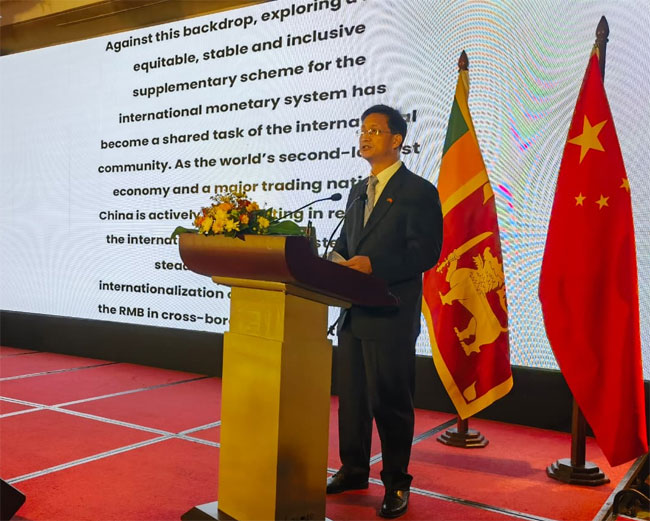At a critical period for Sri Lanka’s economic recovery and structural adjustment, expanding cooperation with China’s renminbi (RMB) will undoubtedly inject fresh momentum into trade facilitation, investment attraction and financial system modernization, says Chinese Ambassador Qi Zhenhong.
He made these comments during the RMB Internationalization Forum held in Colombo on Wednesday, October 29.
He stated that as the global economic landscape has undergone profound adjustment and the globalisation continues to advance, the dollar-centric system has gradually exposed its structural contradictions — such as imbalances in liquidity provision, spill-over of financial risks, and the marginalisation of the interests of developing countries.
The Chinese Ambassador stressed that the dominance of a single currency means that its policy changes create a “tidal effect” on the global economy: once a major economy tightens policy rapidly to curb inflation, capital will accelerate its retrenchment, and other countries — especially developing countries — may be forced to suffer passively from exchange-rate shocks, rising financing costs, and setbacks to growth.
Against this backdrop, exploring a more equitable, stable and inclusive supplementary scheme for the international monetary system has become a shared task of the international community, he emphasized.
Ambassador Zhenhong said that as the world’s second-largest economy and a major trading nation, China is actively participating in reform of the international monetary system and steadily promoting the internationalisation of the RMB.
The use of the RMB in cross-border trade settlement, reserve currency functions and investment tools is steadily expanding; its role is increasingly prominent, especially in fields such as energy, finance and infrastructure, he said.
“Today, as we discuss the internationalisation of the RMB, our hope is to provide a pragmatic “supplement and refinement” solution within the existing framework of the international monetary system.”
“We aim to offer market participants more currency choices, increase resilience to the global financial safety-net, and to broaden the institutional space for shared development. This reflects both the spirit of multilateralism and openness to cooperation, and responds to the tendency of diversification in the international monetary system.”
“In particular for a developing country like Sri Lanka, this process is of significant and practical importance,” he added.
The Chinese Ambassador said the broader use of the RMB helps diversify the structure of foreign exchange reserves, reduce exchange-rate risk, and provide more stable and lower-cost settlement channels in bilateral trade, investment and financing — thereby strengthening the local currency’s stability and macro-economic resilience.
“At a critical period for Sri Lanka’s economic recovery and structural adjustment, expanding cooperation with the RMB will undoubtedly inject fresh momentum into trade facilitation, investment attraction and financial system modernization,” he noted.
Ambassador Zhenhong said the internationalisation of the RMB is a market-driven, enterprise-led, risk-controllable and gradual process and that it is a natural consequence of China’s deep integration into global division of labour and the continuous expansion of trade and investment linkages.
Chinese Ambassador’s Full Speech:
Distinguished Guests, Ladies and Gentlemen,
Ayubowan! Vanakkam! Good evening! It is my great pleasure to join you at this Forum on the Internationalisation of China’s currency,RMB. First of all, I would like to thank the organisers for providing such an important platform for dialogue.
This year marks the 80th anniversary of the founding of the United Nations. Since the UN’s establishment, the international monetary system has evolved from a dollar-centred fixed-exchange-rate regime to a dollar-centred floating-rate system. Whether during the Bretton Woods Conference era or under the new system established by the Jamaica Agreement, the US dollar has consistently served as the world’s major reserve and settlement currency, and formed the financial foundation of the post-war international economic order. Over the long run, this system has provided institutional under-pinnings for global economic recovery and trade prosperity, maintained the basic stability of the international financial order, and advanced the process of world economic integration.
However, as the global economic landscape has undergone profound adjustment and the globalisation continues to advance, the dollar-centric system has gradually exposed its structural contradictions — such as imbalances in liquidity provision, spill-over of financial risks, and the marginalisation of the interests of developing countries. The famous remark by former US Treasury Secretary John Connally in the 1970s — “the dollar is our currency, but it’s your problem” — still resonates more than half a century later. The dominance of a single currency means that its policy changes create a “tidal effect” on the global economy: once a major economy tightens policy rapidly to curb inflation, capital will accelerate its retrenchment, and other countries — especially developing countries — may be forced to suffer passively from exchange-rate shocks, rising financing costs, and setbacks to growth.
Against this backdrop, exploring a more equitable, stable and inclusive supplementary scheme for the international monetary system has become a shared task of the international community. As the world’s second-largest economy and a major trading nation, China is actively participating in reform of the international monetary system and steadily promoting the internationalisation of the RMB. The use of the RMB in cross-border trade settlement, reserve currency functions and investment tools is steadily expanding; its role is increasingly prominent, especially in fields such as energy, finance and infrastructure.
Today, as we discuss the internationalisation of the RMB, our hope is to provide a pragmatic “supplement and refinement” solution within the existing framework of the international monetary system. We aim to offer market participants more currency choices, increase resilience to the global financial safety-net, and to broaden the institutional space for shared development. This reflects both the spirit of multilateralism and openness to cooperation, and responds to the tendency of diversification in the international monetary system.
In particular for a developing country like Sri Lanka, this process is of significant and practical importance. Broader use of the RMB helps diversify the structure of foreign exchange reserves, reduce exchange-rate risk, and provide more stable and lower-cost settlement channels in bilateral trade, investment and financing — thereby strengthening the local currency’s stability and macro-economic resilience. At a critical period for Sri Lanka’s economic recovery and structural adjustment, expanding cooperation with the RMB will undoubtedly inject fresh momentum into trade facilitation, investment attraction and financial system modernisation.
Friends,
The internationalisation of the RMB is a market-driven, enterprise-led, risk-controllable and gradual process. It is a natural consequence of China’s deep integration into global division of labour and the continuous expansion of trade and investment linkages.
In the first half of 2025, the value of cross-border RMB receipts and payments reached 35 trillion yuan, a year-on-year increase of 14%. The central banks or monetary authorities of over 80 countries and regions have incorporated the RMB in their foreign exchange reserves. RMB-denominated bonds and stocks have been incorporated into major global asset benchmark indices. Hong Kong has developed into the core hub for offshore RMB business, while distinctive offshore RMB markets have formed in London, Singapore, Dubai, and elsewhere.
The total RMB deposits in major offshore markets amount to approximately 1.6 trillion yuan, and the outstanding amount of offshore RMB bonds and “Panda bonds” is about 2 trillion yuan. The Cross-border Interbank Payment System (CIPS) has attracted 1,729 participants, covering over 5,000 licensed banking institutions across 189 countries and regions on six continents. The cross-border use of the digital yuan (e-CNY), along with rapid domestic and cross-border payments and QR code interoperability, is steadily progressing, further improving the efficiency of cross-border settlements.
Currently, RMB clearing banks have been established in 33 countries and regions, covering major international financial centers. The RMB is included in the IMF’s Special Drawing Rights (SDR) basket with a weight of 12.28%, ranking third after the US dollar and the euro. The People’s Bank of China has signed 32 bilateral local currency swap agreements with counterparts, including the European Central Bank and the central banks of New Zealand, South Korea, Indonesia, Brazil, and Saudi Arabia, with a total scale of about 4.5 trillion yuan, broadly covering major global economies.
In these practices, broader use of the RMB helps simplify procedures, lower costs, and enable enterprises to hedge risks and build resilience. China’s attitude toward RMB internationalisation has always been prudent and pragmatic. Its aim is to make the global financial system more diversified and more stable, and to give developing countries more space for equal participation and sharing of opportunities.
Friends, Ladies and Gentlemen,
We are ready to work with all parties to uphold the principles of “extensive consultation, joint contribution and shared benefits”, to adhere to openness, inclusiveness and win-win cooperation, making the RMB an important piece in the “diversified mosaic” of the international monetary system so as to inject more balance, resilience and inclusiveness into the global financial system.
All of you present here today are experts and practitioners who have worked deeply in the monetary and financial field for many years. I believe your insights and unique perspectives will provide new inspiration and impetus for our joint exploration of RMB internationalisation. I very much look forward to the collision of ideas and the fusion of wisdom by hearing your valuable opinions. I hope that through this forum, we will gather consensus, pool wisdom, translate intellectual outcomes into pragmatic action, and together push the internationalisation of the RMB to a new level.
Let’s walk together with greater inclusiveness and more pragmatic action to jointly write a new chapter in the internationalisation of the RMB and regional cooperation development at this new historical starting point. Thank you all!











